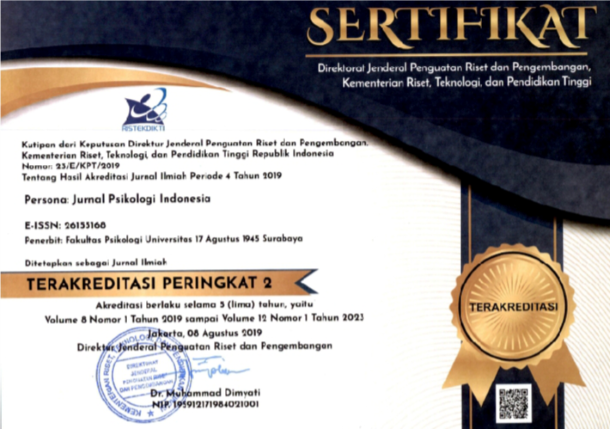Efek Pemaafan dan Ketakutan Pada Kejahatan Terhadap Penilaian Keadilan Restoratif Bagi Anak Pelaku Kejahatan
Abstract
Abstract
The study aims to determine effect forgiveness and Fear of Crime toward Restorative Justice judgment. The study involved 110 subjects. Collecting data used Restorative Justice Scale, Transgression-Related Interpersonal Motivations Scale-18 (TRIM-18), and Fear of Crime scale. The results showed that there are significant effect of forgiveness and fear of crime simultaneously toward restorative justice. At the partial analysis show that forgiveness has positive effect toward restorative justice, otherwise fear of crime has a negative influence toward restorative justice.
Key word: forgeviness, fear of crime, restorative justice.
Â
Â
Abstrak
Penelitian ini bertujuan untuk mengetahui pengaruh pemaafan dan ketakutan pada kejahatan terhadap penilaian keadilan restoratif. Penelitian ini melibatkan 110 subjek. Pengumpulan data menggunakan Skala Keadilan Restoratif, Motivasi Interpersonal Terkait-Motivasi Skala-18 (TRIM-18), dan Skala Takut pada kejahatan. Hasil penelitian menunjukkan bahwa ada efek signifikan dari pemaafan dan ketakutan terhadap kejahatan secara bersamaan terhadap keadilan restoratif. Pada analisis parsial menunjukkan bahwa pengampunan memiliki efek positif terhadap keadilan restoratif, jika tidak takut kejahatan memiliki pengaruh negatif terhadap keadilan restoratif.
Kata Kunci: Pemaafan, Ketakutan pada kejahatan, keadilan restoratif
Downloads
References
Demker, M., Towns, A., Duus-Otterström, G & Sebring, J (2008) Fear and Punishment In Sweden Exploring Penal Attitudes. Punishment Society; 10; 319-332
Franklin, T., W., Franklin, C.A &. Fearn, N. E (2008) A Multilevel Analysis of the Vulnerability, Disorder, and Social Integration Models of Fear of Crime. Social Justice Research. 21:204–227 DOI 10.1007/s11211-008-0069-9
Garofalo, J. (1981). The Fear of Crime: Causes and Consequences. Journal of Criminal Law and Criminology, Vol. 72, No. 2: 839-857.
Institute of Criminal Justice Reform (2013). Panduan praktis untuk anak yang berhadapan dengan hukum https://icjrid.files.wordpress.com/2013/01/panduan-praktis-untuk-anak-yang-berhadapan-dengan-hukum.pdf. Diakses 21 Maret 2016
McCullough, M. E. (2000). Forgiveness as Human Strength: Theory, Measurement, and Links to Well-Being. Journal of Social and Clinical Psychology, 19, 1, Psychology Module: 123.
McCullough, M. E. et, al. (2003). Forgiveness, Forbearance, and Time: The Temporal Unfolding of Transgression-Related Interpersonal Motivations. Journal of Personality and Social Psychology, Vol. 84, No. 3 540-557.
Nashriana. (2012). Perlindungan Hukum Pidana bagi Anak. Jakarta: Raja Grafindo Persada.
Noll, D. E. (2003). Restorative Justice: Outlining a New Direction for Forensic Psychology. Journal of Forensic Psychology Practice, 3:1, 5-24.
Nuqul, F. L., (2009) Telaah penilaian pada kejahatan: Perbandingan Kejahatan seksual dan non seksual. Realita, 7, 1-14
Nuqul, F. L., (2011), Nilai – Nilai Dalam Pertimbangan Seriousness Of Crime: Kajian Pada Komunitas Muslim. Jurnal Asy-Syirah, 40. 1125-1142
Nuqul, F. L., (2013) Peran Usia Pelaku Dalam Sikap Masyarakat Awam Terhadap Pelaku Kejahatan Seksual Pada Anak. Psikologika, 18, 107-118
Rogers, D. L. (2004). Struktural Analisis of Treatmen and Punishment Attitudes toward Offenders. Disertasion Ohio: The Ohio State University.
Santoso, T & Zulfa E, A. (2013) Kriminologi, Jakarta: PT Raja Grafindo Persada
Tyler, T (2006), Restorative justice and procedural justice:dealing with rule breaking. Journal of Social Issues, 62: . 307—326
Veneziano, C., & Veneziano, L. (2002). Adolescent sex offenders: A review of the literature. Trauma Violence & Abuse, 3, 247-260.
Vizard, E., H, N., & McCrory, E. (2007). Developmental trajectories associated with juvenile sexually abusive behavior and emerging severe personality disorder in childhood: 3-years study. British Journal of Psychiatry, 190, 27-32.
Witvliet, C.V.O et al. (2007). Retributive Justice, Restorative Justice, and Forgiveness: An Experimental Psychophysiology Analysis. Journal of Experimental Social Psychology, 44, 10-25.
Wright, M. (2002). The Paradigm of Restorative Justice. Minneapolis: VOMA (Victim Offender Mediation Association) Connections.
The author who will publish the manuscript at Persona: Jurnal Psikologi Indonesia, agree to the following terms:
1. Authors retain copyright and grant the journal right of first publication with the work simultaneously licensed under a Creative Commons Attribution ShareAlike License that allows others to share the work with an acknowledgment of the work's authorship and initial publication in this journal.
2. Authors are able to enter into separate, additional contractual arrangements for the non-exclusive distribution of the journal's published version of the work (e.g., post it to an institutional repository or publish it in a book), with an acknowledgment of its initial publication in this journal.
3. Authors are permitted and encouraged to post their work online (e.g., in institutional repositories, pre-prints sites or on their website) prior to and during the submission process, as it can lead to productive exchanges, as well as earlier and greater dissemination of published work







